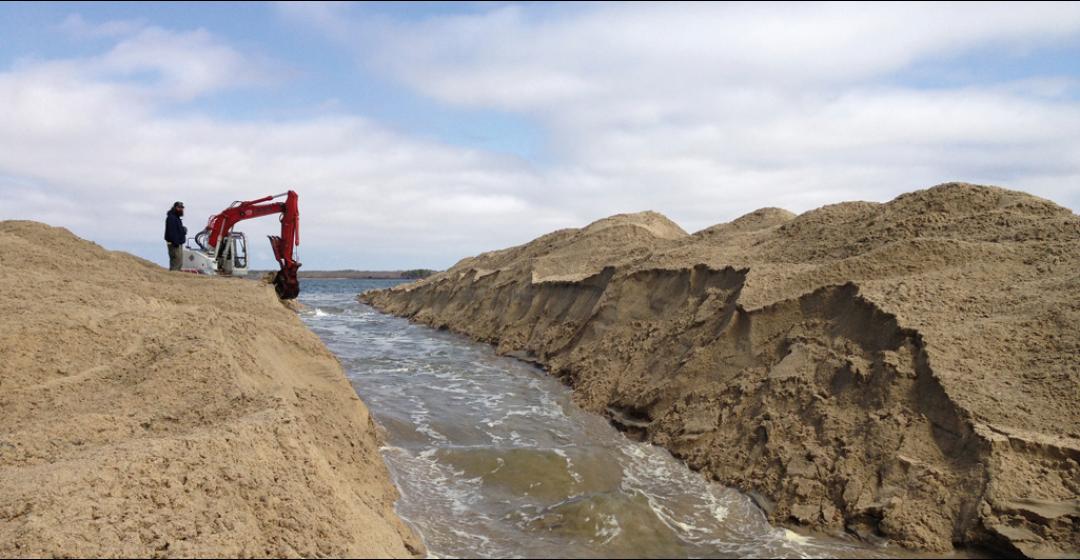Three or four times a year, an excavator crawls out to the barrier beaches between some of our great ponds and the open ocean and makes incisions in the sand that open up floodgates. This is a diesel-powered version of a ritual that goes back to ancient times.
“We learned to breach ponds from the Native Americans,” explains Paul Bagnall, Edgartown shellfish constable. “Back in the old days they would do it by hand or they would use a sand scoop, which is sort of like a half of a bulldozer blade, pulled by an ox.”
Sand scoops were eventually replaced by bulldozers, which in turn gave way to excavators. An excavator can create an opening in about four hours, or half the time it took a bulldozer. It can also make adjustments to the channel after the water begins to flow. And it’s less risky.
“With a bulldozer, the last thing you do is make a long pass down the path of the channel from the pond to the sea and the water is literally following right behind you,” says Bagnall. “A while back a driver was making the last run and when he turned at the end to get out of the channel, the engine died and he was stuck sideways in the middle and had to be towed out.”
A breach, whether caused naturally by a storm or opened by hand, increases circulation and raises the salinity level of the pond to make it habitable for shellfish. For a century after 1850, the subject of manmade openings in the barrier beach was highly controversial in Edgartown, with the owners of the herring fishing rights at the manmade Mattakesett Creek using their political power in town and in Boston to prevent most openings through the barrier beach. Old timers will tell you that there was a time when you could almost walk across the pond on the backs of the herring. If the barrier beach was closed, they could be harvested easily as they entered through the creek, which connects Edgartown Great Pond to Katama Bay. When the beach was breached, however, the fish came and went through the outlet to the sea, making fishing difficult.
By the 1920s the herring industry was waning. The demand for herring oil had diminished and it was expensive to transport the fish off-Island. Fishermen still used herring as bait and someone even came up with a way of making a synthetic pearl out of the herring skin, but the days of herring being a viable commercial product on the Island were coming to a close.
Then, in 1928, a winter storm opened up the pond to the sea for about a year and a half. The salinity level in the pond increased enough that quahogs flourished and bay scallops started to appear. Shellfishing became big business, and in 1949 the state legislature authorized the town to open up the pond. Though the owners of Mattakesett threatened to sue for damages, in 1951 the pond was opened. “Not many spectators went to the beach to see the pond go out,” the Vineyard Gazette reported on April 20 of that year, “however, it may be that on Wednesday night the ghosts of the old timers who, in the sixties of the last century, dug the beach and let the pond out under cover of darkness, may have rallied round with jubilation.”
Today, Edgartown Great Pond is opened twice in the spring, around March 15 and May 15, and then again around August 15. If there’s a lot of precipitation in the fall causing the salinity level to dip too low, it may also be opened around December 15. When closed, the combination of precipitation and incoming groundwater gradually increases the level of the pond and dilutes the salinity.
Ideally, the water in the pond should be about four feet above sea level for the beach to be breached. If the level in the pond is less than two and a half feet higher than the oean, the pond can’t be opened because after the initial surge, the tide will wash sand back in and close the opening.
To create the opening, an excavator digs a narrow trench and then lets nature have its way. “The excavator only removes about 2 percent of the sand,” Bagnall says. “The other 98 percent is washed out by the escaping water. Within a few hours, the channel widens to about seventy-five feet. Within a few days you start getting a return tide into the pond and within a couple of weeks you begin to see a significant change in the salinity level.”
In time, you’ll also notice a change outside the channel. The sand that was churned out by the rushing water begins to get pushed back in by the incoming tides and a sandbar begins to form. Eventually the sandbar will begin blocking the entrance and the channel will actually migrate down the beach to the west. In about two weeks to a month the channel will be completely closed.
If you get a chance to see a pond opening, don’t miss it. Blues, stripers, and seals crowd the opening to feast on incoming and outgoing baitfish. Ospreys, falcons, hawks, gulls, and the Island’s occasional winter resident, the snowy owl, soar overhead while sanderlings and plovers bob for krill on the flats. After five days you may even see brave tubers and kayakers riding the rapids – it’s nature’s water park.
To see a video showing the opening of the Edgartown Great Pond, visit the Edgartown
Shellfish Department Facebook page at facebook.com/edgartownshellfish.





